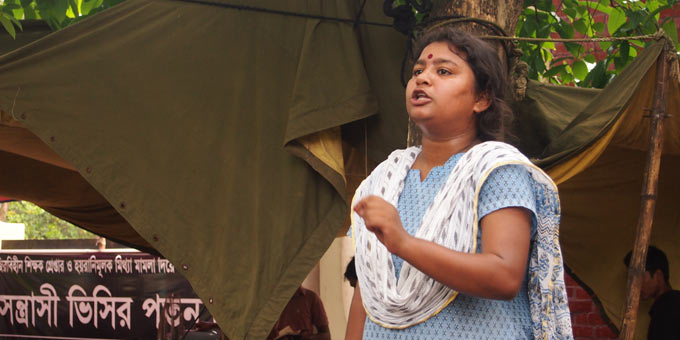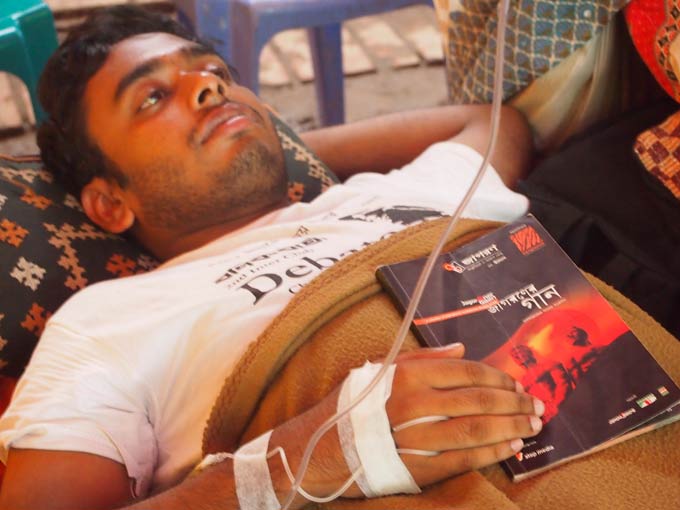
A student stands to speak at Jahangirnagar University, 2012. Photo by Saydia Gulrukh.
A friend sent me a jubilant newspaper clipping by mail from Bangladesh. The manila envelope took two weeks to arrive at Oberlin College—it was pre-internet time. The headline read, in 48-point font, “The Photo We Were Not Allowed To Print.” Underneath was a grainy image of students running over barricades as shield-carrying police chased them with sticks. That was 1990.
I tenderly laminated the page and attached it to the door of my dormitory room, writing a note above it in black marker ink: “This is student politics.”
While I was navigating my first year at Oberlin, Bangladesh’s longest-running military regime (1982–1990) was overthrown by a sustained tide of mass protests. The abrupt end of the junta, with President Hussain Mohammad Ershad abandoned by his own army, recalled the last scene of Satyajit Ray’s absurdist classic Hirak Rajar Deshe (1980). As a grand statue of the king is pulled down, people cheer dori dhore maro tan/raja hobe khan khan (“now grab and pull that rope/the king will shatter into pieces”).
My dormitory provocation was a reminder of other contexts, where the stakes were higher. People died, governments fell.
Oberlin has a long progressive tradition, going back to its antebellum history, and more recently, its organizing role in the civil rights and Vietnam War era. In the 1980s, it was a flashpoint for anti-apartheid activism. But with Nelson Mandela out of prison, campus political organizing seemed to be turning inward. The biggest campaign at that moment was about students not being allowed to protest on the president’s manicured house lawn. My dormitory provocation was a reminder of other contexts, where the stakes were higher. People died, governments fell.
But within that laminated image was also a faint touch of glamorization. I had left for America in 1989, just as the Dhaka University battles against the military reached fever pitch and classes were halted. I never got the results of my first year exam. Instead, I started again as a freshman at Oberlin. Looking back at the Dhaka years, I tended to get misty-eyed about the political power of that campus.
The euphoric news headlines about the fall of the Ershad government obscured the high price paid by students. Campus protests led to the government’s frequent orders to shut down classes, which produced the dreaded “session jams”—extreme delays in graduation caused by the recurrent closures. Some of my classmates, who stayed back in Dhaka, waited seven years to get their final degrees. Politics had real, immediate costs for them; possibility and danger were perpetually entwined.
A Long Tradition
In Bangladesh, student politics, physically based around university campuses, have a long and effective tradition. During various stages in the country’s history—as British India, then East Pakistan, and finally an independent nation after 1971—resistance to power has often crystallized through student protests. Key anniversaries are routinely memorialized: 1952 (language riots after Pakistan attempted to impose Urdu language on all regions); 1968–69 (anti-military protests that toppled General Ayub Khan); 1971 (the Bangladesh independence war, during which students and professors were targeted by death squads); 1990 (the ouster of the Ershad military regime); and most recently, 2007 (anti-army riots which led to the departure of an unelected “caretaker government”).
To be a public university student in Bangladesh is to also be a protagonist in a ferocious and instrumentalized politics.
Within this legacy, however, are three “buts”—counter-streams that threaten the future state of public education. First, as universities became political nerve centers, their role as research institutions diminished. The brain drain is at a high point, with many scholars now choosing to join nongovernmental organizations, think tanks or overseas universities instead. Second, as public universities have become ensnared in the notorious “session jam,” and in response to a population bulge of people under the age of 30 (around 70% of the total population), private universities have mushroomed. This means the class diversity once present on public campuses has vanished. Students who can afford it are fleeing to private universities.
The third crisis for public education is related to the university’s central role in anti-state protests, which have repeatedly brought down governments, both civilian and military. Aware and afraid of this potential, every democratically elected government since the 1990 fall of Ershad has focused on “capturing” university campuses. Each national political party has a student wing (subject of my earnest yearning in the pre-1990 era) and uses it to control the campus. All this is accompanied by muscle power, including the aggressive display and use of hockey sticks, machetes, and pistols.
Outside the Capital
While the central campus of Dhaka University has long been besieged by power politics, many of us like to think, perhaps naively, that Jahangirnagar University can hold on to a different reality. Located just outside the capital, in the suburb of Savar, the school maintains a reputation for having a strong leftist campus. Many of its students have gone on to play active roles in national political campaigns, including the ongoing Campaign for Protecting Oil & Gas from Multinationals and the movement against open-pit coal mining. Students and professors with links to Jahangirnagar have also been involved in a recent attempt to create a broad alliance of leftist parties, called Bam Boloy (Left Belt).
In spite of a strong left history, Jahangirnagar is now gripped by the same muscle politics strangling other public campuses. As the country’s only fully residential campus, the sprawling university is also a small town and community in miniature. This means there is also more potential for a lucrative division of spoils. Student political groups not only guide political activity, they also control the campus economy, collecting money from transactions like the allocation of hostel housing, on-campus transportation, and shops.
After the Awami League party came to power in 2009, its student wing (the Bangladesh Chhatra League or “BCL”) took control of the campus. Since then, the BCL has split into two factions over rivalries about the appointment of student council seats. One faction is aligned with the university’s Vice Chancellor (VC), chemistry professor Shariff Enamul Kabir, and was ascendant in the battle for control of the campus.

Student graffiti mocking Vice Chancellor Shariff Enamul Kabir covers the grounds of the university campus, 2012. The thought bubble reads, “I will eat you, I am the VC.” Photo by Saydia Gulrukh.
Things came to a head earlier this year when a student was killed by members of his rival faction. The vicious nature of the murder—a prolonged beating with rods, within earshot of security guards—along with a photo of VC Kabir eating cake from the hands of one of the alleged ringleaders, generated angry headlines. Alumni and former professors of the university joined forces with student activists and teachers under the slogan “Save Jahangirnagar.”
Campus organizing makes student life perpetually volatile–one step away from becoming homeless.
After a summer of protests, rallies and hunger strikes by professors and students, a habitually obstinate government (witness the removal of Muhammad Yunus from Grameen Bank, and the World Bank bridge corruption scandal) finally backed down. The Vice Chancellor was removed, and Professor Anwar Hossain was brought over from Dhaka University to serve as the new VC.
The situation is still not stable. The symbolic removal of one man did not purge the powerful student wing that owes him loyalty. While I was writing this, new faction battles shook the campus. The authorities shut down classes for the second time this year, and asked students to vacate their hostel rooms. A few days later, classes reopened. This unstable cycle may continue.
To be a public university student in Bangladesh is to also be a protagonist in a ferocious and instrumentalized politics. Successful campus organizing has national impact; but this same organizing also makes student life perpetually volatile–one step away from becoming homeless, forced into permanent vacation.

A student enduring a hunger strike in protest of Vice Chancellor Kabir’s role in the death of a Jahangirnagar University student, 2012. Photo by Saydia Gulrukh.
A Day Off
By the summer, the campus had returned to some semblance of normality, and I went out for a visit. Manosh Chowdhury, a professor of anthropology who was also one of the leaders of the movement against the VC, had asked me to give a talk to students. Jahangirnagar is home to the country’s first anthropology department and I was curious to meet the students.
Manosh has diverse interests and likes to make unexpected connections. Coaxing shy students into asking questions, he linked art practices with political activism. When anthropologist and activist Saydia Gulrukh gave a talk to the same classroom a few weeks later, I could see (via a student’s mobile phone video) Manosh reciting a poem tracing the colonial roots of an Ivory Soap jingle—one I had translated for Saydia. Watching this and other clips of him speaking, you get the sense of a restless polymath, energized by new overlaps and hybrid forms.
Later, Manosh took us to lunch at the bot tola (banyan tree). I imagined eating under it, but the area had proper dhaba restaurants, and the tree did not actually provide us shade (rather, it served as a geographic marker for rickshaw drivers). Unlike other teachers who choose to stay in the faculty lounge, Manosh knew many of the students there and spoke with them readily. Earlier, he had told me, “If I can’t have real interactions with students, what’s the point of teaching here?”
Among the students who joined our lunch table was a cultural activist from the theater department. His arm was in a cast, and his girlfriend sat next to him and gently helped him eat (the fish bones would probably be difficult to pick out with one hand). Manosh explained that he had been one of the protesters, and VC-aligned thugs had broken his arm.
He seemed embarrassed at the attention, and went back to eating.
I asked, “Do you think it’s over? Will the campus return to normal?”
He replied, “We won a small victory, but it’s only beginning. Long way to go.”
I wondered what the next year would bring for the movement, and for this student. The cause was just, but I hoped he would not become collateral damage, losing years of classes while national political forces played games with the campus.
Manosh cautioned that I was being too simplistic in analyzing the public/private university tradeoff. “Private universities are seen as a local fact of negotiating the social classes. But with some close observation, you may find them to be an expression of a global project.”
A global project to depoliticize education.
A long way away from that laminated image at Oberlin.
Manosh Chowdhury speaking to students, video by Naeem Mohaiemen.
Special thanks to the Robert Sterling Clark Foundation for making this Global Resident Report possible.

